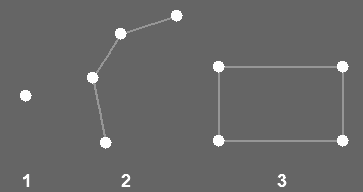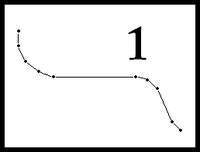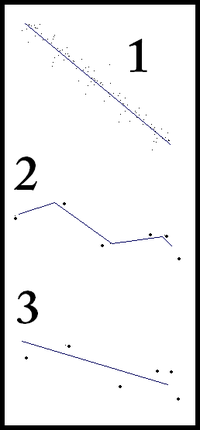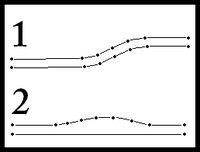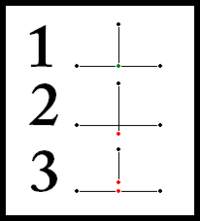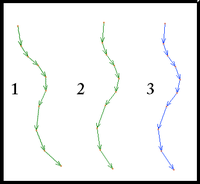Edit maps
| This is a beginner's guide on how to contribute free geographic data to OpenStreetMap. |
OSM data
OSM's data is made from the following elements:
- Nodes: The dots that are used to mark specific locations (such as a post box). Two or more nodes are used to draw line segments.
- Ways: A list of nodes, displayed as connected line segments. They are used to create roads, paths, etc.
- Closed Ways: Closed ways are ways that go in a complete loop. They are used to create "areas," such as parks, lakes, islands or buildings.
- Relations: When ways are linked but do not represent the same physical thing, a relation is used to describe the role of each way. Relations are used to create map features. such as cycling routes, turn restrictions and areas that are not contiguous. A long way, such as an interstate or a state highway with multiple segments, should be grouped into a relation for that highway. Another example is a national park with several locations that are separate from each other. These also should be grouped into a relation.
(1)node (2)way (3)closed way. All these elements can carry tags, describing name, type of road etc.
You have a choice of three main editors:
- iD is the newest editor available directly from the edit tab. It is written in HTML5/Javascript.
- Potlatch is an older Flash-based editor also available directly from the 'edit' tab.
- JOSM is more powerful than the in-browser editors and is preferred by many experienced contributors, but needs to be downloaded separately and takes a bit more effort to get started with.
General tips for adding roads or other ways
- Q: Where are my arrows, I just have lines?
- A: In JOSM, go to Edit, Preference and then Display Settings and click to draw Direction Arrows.
- Q: One of my way-segments has arrows at both ends, is that correct?
- A: If there are arrows at both ends, then either 2 ways overlap and use the same nodes, or the way goes back on itself. The way may have been created when inserting nodes into the way, when not deselecting before the next insert.
Potlatch, the online editor
Potlatch is an editor for OSM data. It is recommended for beginners. To use it, you first must sign in or register (see the top right of the Potlatch screen for the "log in" and "sign up" links). Then, to start, navigate to a map location on www.openstreetmap.org and click on the 'Edit' tab along the top of the screen.
There are several places to get help about using Potlatch:
- The online help of potlatch itself
- These video screencasts on how to use OSM and Potlatch.
- Potlatch/Primer
Some tips
- It is important to allow data to load, before presuming it isn't there. A relatively common mistake is to duplicate data by adding, before it's clear what's already been added.
- Be sure to check if something is where it is for a reason before shifting it to a seemingly better location.
- At the bottom left of the editing page, the centre bottom button allows you to view GPS data. Shortcut G.
- Shift-click anywhere on a way to add a node.
- Click on a way, then click on any node on the way to select that node. You can now move it by simply dragging it.
- Shift-click on a node to start a new way. This is helpful for joining roads.
- To delete a node, select the way, then select a node as above, then press ⌦ Delete.
- To copy attributes from a previously-selected way, press R. This is good for adding speed limits to a way that someone else has added previously, e.g. "maxspeed=60".
- To extend a way, select this way, click the node at the end from which you would like to extend, then click for each node to go ahead with the route of the way. Set new nodes or snap to a node of an existing way by moving over the node (it will be highlighted blue). To finish a way, press ↵ Enter. Repeat the attributes from the previously-selected way as described above.
- Select a node to drag it. Save the changes as described above.
- Pressing D will allow you to see GPS traces more clearly.
JOSM
JOSM is a java-based map editor. Also beginners can use it.
- How to download data from OSM into JOSM.
- A quick lesson on creating roads in JOSM.
Downloading data into JOSM
Before you start to edit by JOSM, you need to download OSM data and GPS traces from OSM database into the application:
- Click File -> Download from OSM menu
- Navigate to the area you wish to edit, by using:
- Mouse wheel: zoom in/out
- Right click and drag: move the map
- Left click and drag: mark the area to download
- At the top of the download window choose what to download:
- OpenStreetMap Data: OSM map data, you will edit this, so you will certainly need this.
- Raw GPS Data: Data gathered from GPSs by OSM users. It's recommended to download all GPS tracks for more accurate drawing.
- Click Download
Important: JOSM will hatch the area outside the downloaded area. Never edit on the hatched area, because it may already contain the objects you wish to draw.
If you press the "Download from OSM" menu later, it will select the currently viewed area automatically, so you can easily download adjoining parts of the map. Don't worry, this will not affect your already edited objects and it will not duplicate already downloaded OSM objects.
You can open your own GPS tracks using the File -> Open... menu (.gpx format). But it is recommended to download other users' GPS tracks too, for better accuracy.
- Q: What user name and password does JOSM require?
- A: The e-mail address and password that you registered as OSM account (not of the wiki). It is advised that you do not use an important password as data is sent unencrypted to OSM. To use encrypted secure authentication, try OAuth (Edit -> Preferences -> Connection settings).
How to create your first basic road in JOSM
- 1. Use the Create tool and click to place nodes. Way-segments will link the nodes (shortcut = A).
- * To create just nodes press Esc after every added node to unselect all and hold down Ctrl while clicking at the next position.
- * To create a way leading on from another way or from a node, select the node (shortcut = S), then create (shortcut = A).
- 2. Move the way around, or move individual nodes by selecting them first, so it's where you want it (shortcut = S).
- 3. Tag the way with the appropriate tag for its type. Tags are added in the Properties section (Opens in side bar; alt+P). The Properties section lists current tags within the current selection. The way should change colour to indicate when it is tagged.
See also
- The Beginners' guide
